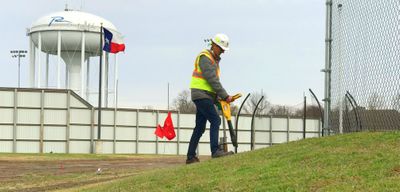
I Went To School For This
We often get asked whether we went to school to learn GPR/ utility locating. Our technology and industry remain somewhat novel to most casual observers, who want to know what it takes to become an expert in GPR. The answer to the school question is both ‘yes’ and ‘no’.
No, the utility locating industry is not large enough to warrant degree programs. But, yes, GPRS has a world-class training program, fit with dedicated instructors, a well-developed classroom curriculum, and even a ‘practice’ field of deliberately positioned buried utilities for the new trainees to test their skills on. We also have an advanced course for continuing education and many hours of online videos and interactive content. All new team members go through a months-long ride along, and we have rigorous quality control protocols and SOP’s. We have an external certification (www.simspec.org) that governs both our initial and ongoing training standards.
But there is another, even greater sense in which most of us can say, “Yes, I went to school for this”. That is, we regularly scan America’s school and universities, and those jobs are some of the most challenging and rewarding jobs we do. In our experience, schools have more utilities per acre than almost all other non-industrial facilities (second only, perhaps, to theme parks). Schools, especially larger universities, are often constructed in phases, through an iterative process, as they grow and expand. Utilities are layered on top of one another, sometimes abandoned in place, sometimes redirected at odd angles.
At GPRS, we are delighted by the challenge and the growth opportunity afforded by difficult jobs. Utility locating at America’s schools offers a prime opportunity for such growth. In the process, we get to play a small part in investing in the next generation. That element – that sense that we are part of building up the next generation, is as rewarding as it is sobering. My own daughter’s elementary school recently lost AC for almost a week, in September, all because a contractor rushed forward and hit a chilled water line (they had not used GPRS!). Going through that experience, as a parent, gave me a renewed appreciation for what we accomplish every day—not just monetarily, in the form of savings on repairs, but tangibly, as we protect those who rely on America’s utility infrastructure, including our nations students.
If you are considering whether to get a utility locate prior to digging or drilling on a school property, let me strongly urge you to get the locate done. Honestly, our customers typically get a better ROI on locating school facilities than on most other jobs. This is both because of the sheer number of utilities we generally encounter, and because those utilities are often buried shallower than they would be at many other facilities. Just this month, we located a local private catholic school prior to an environmental study that would be drilling 13 vertical soil borings.
Of their 13 original locations, 7 were found to be within 1’ of a buried utility, which is an astounding rate! If they had bypassed the locates, they would have hit site lighting for the football stadium, two storm lines, two small electrical conduits, and a sanitary line that was 18’ deep (their vertical bores were 35 deep—just imagine that repair!). By the time we located the 7th utility conflict, we could not help buy laugh at the absurdity of the bad luck they would have encountered if they had not called in a locate, but we were equally grateful to have prevented all that mayhem.
Before you dig or drill, call us at (214) 471-9001. We are passionate about what we do, and we are eager to serve your team in building a safe environment for the next generation to grow.
